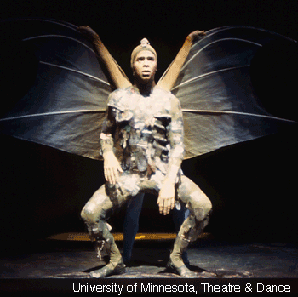Melodrama: A Forking Path
Before commencing this academic year, I decided to populate my syllabus with plays I have never read. One of my favorite occupations, reading, has suffered a tremendous blow at the hands of my teaching schedule (as John Fletcher told me would be the case). I figured I would force myself to read new plays and some secondary source material by teaching individual works and historical periods about which I knew either nothing or very little. (I imagine all of this sounds familiar to you as you read this.) Melodrama as a genre was something I knew almost nothing about. Somehow, after four years at New York University and five years at the University of Minnesota, I came into contact with melodrama only twice. The first time was as a TA in Theatre History when we read Black-Eyed Susan by Douglas Jerrold. The second time was during a graduate seminar on historiography when we encountered secondary source material about the infamously successful adaptations of Uncle Tom’s Cabin (here, I’m thinking specifically of Sadiyah Hartman’s Scenes of Subjection: Terror, Slavery, and Self-Making in 19th-c. America). In both cases, the material was presented as a stepping-stone to the larger concern of historiographical methodology. We didn’t dwell on melodrama proper; rather, we framed melodrama within larger issues of, on the one hand, appropriating revolutionary ideas into the nation-building project and, on the other, the connection between archive and repertoire.
I decided to confront my foggy memory and dearth of knowledge on the subject of nineteenth-century melodrama this semester, but time constraints forced me to split the difference. I would dedicate a week to melodrama, asking my students to read Black-Eyed Susan and something else, something I had yet to discover. With the plan in place I began to look for titles. After numerous searches I located Rene Charles Guilbert de Pixérécourt (1773-1844), the so-called “father” of French melodrama, a name I had never come across before. Digging deeper, I found that Daniel Gerould and Marvin Carlson had collaborated as editors on a volume of four works by Pixérécourt. Then I did the math: the “father” of French melodrama + two respected scholars in the field = something I need to look into. I got Gerould’s and Carlson’s book and decided immediately to place The Dog of Montargis on my syllabus.
A play featuring a dog. Perfect. What historiographical challenge awaits me within the pages of this story about Aubri and his faithful companion? Before I had the opportunity to answer that question, I received my copy of Black-Eyed Susan from Inter-library Loan. The book was actually a bound collection of photocopies of the original text published by Clinton T. De Witt in 1854. Looking closely at the first page, I became greatly disturbed. There I found an advertisement for the catalogue of “De Witt’s Ethiopian and Comic Drama,” featuring such titles as Bobolino, the Black Bandit, Dutchman’s Ghost, Noble Savage, Ethi’n Sketch, and roughly ninety more, all grouped under the subheadings of farce or comedy. Suddenly, the historiographical challenge of the Dog of Montargis seemed less important. Should I present this accidental discovery of De Witt’s catalogue to the students? If so, how should I do it? I delved into our library’s databases and indexes to learn more about the “Ethiopian farce” and De Witt, but I found next to nothing. Time was running out because our week of melodrama was rapidly approaching.
To make everything more complicated, I had been receiving pressure from students to lighten the reading load. My current students, as well as numerous comments on my evaluations from last semester, insisted that I made the class too hard and that there was too much reading and writing, especially for a course not classified as writing intensive. Looking over my syllabus, the melodrama week seemed the appropriate time to decrease the amount of reading from two plays to one. Which reading do I eliminate? Black-Eyed Susan? I was already familiar with that play, but this new discovery of De Witt’s catalogue presented a great challenge in terms of linking melodrama to the development of modern racism and discourse on the Other. Do I ditch The Dog of Montargis? It seems like a downright silly play, but I was curious about what lay beneath the silly exterior and I wanted to learn more about the origins (in the Benjaminian sense of the word) of melodrama since I knew nothing about it. Faced with this forking path, I had to choose a direction.
Ultimately, I decided to teach The Dog of Montargis, but I would utilize the discovery of De Witt’s catalogue during our exploration of the Black Arts Movement later in Week Twelve. By covering the historical emergence of melodrama via Pixérécourt, I could lay out some fundamental attributes of the genre. Later in the semester, I could return to melodrama as, on the one hand, a pedagogical strategy for re-visiting ideas and, on the other hand, a way of excavating the historical sediment of the stereotyped movements and images seized upon by the Black Arts Movement. In my next two blogs, I’d like to offer a brief tour of both paths opened by my inquiry into melodrama. The first will visit the ideas I discovered upon meeting Pixérécourt, the second will offer my findings on Ethiopian farces that will eventually culminate in a lesson plan for my class on the Black Arts Movement.

